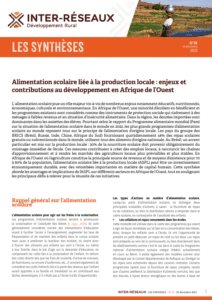_ The structure and importance of the commercial and village based poultry systems in Nigeria
D.F. Adene, A.E. Oguntade, FAO, 2006, 110 p.
The poultry sub-sector is the most commercialized of all the sub-sectors of Nigeria’s agriculture. There are two distinct poultry production systems in the sector: the “commercial” poultry and the “rural” poultry. Between these two distinct systems, we find intermediate systems which have evolved over time, in response to the national agro-economy and consumer demands. They constitute what has now been globally tagged “family poultry” comprising of the indigenous poultry types in some cases or a mixture of both indigenous and exotic hybrids or even totally exotic breeds. The types of poultry commonly reared in Nigeria are chickens, ducks, guinea fowls, turkeys, pigeons and more recently ostriches. It is estimated that over 65% of Nigeria’s commercial poultry is located in the 5 states of Lagos, Ogun, Oyo, Oshun and Ondo. This study presents a desk review of the poultry sector in Nigeria as an entry point to further investigation on, either the epidemiology of Avian Influenza and/or other poultry diseases and their socio-economic impact. It is to provide a 5-year overview of developments in the poultry sub-sector.
Download the document (en)
Analyses of the poultry value chain and its linkages and interactions with HPAI Risk Factors in Nigeria
J. Akinwumi, Iheanacho Okike, Bernard Bett, Fitz Randolph, and Karl M. Rich, ILRI, IPFRI & RVC, 2009, 6 p.
This paper takes a critical look at the Nigeria’s poultry value chain in relation to the spread and control of the highly pathogenic avian influenza (HPAI). In February 2006 and February 2007, highly pathogenic avian influenza (HPAI) struck 3,057 farms in Nigeria, which resulted to the destruction of 1.3 million of the country’s 140 million birds and a compensation that gulped US$5.4 million from the federal government. This brief argues that policy makers may be tempted to consider the spread in the upstream while overlooking the downstream of the value chain which often has a higher impact. To ensure effective HPAI control, the brief suggested targeting of all key actors both in the upstream and the downstream of the poultry value chain. A number of hypotheses were tested from which recommendations were made.
http://www.ifpri.org/sites/default/files/publications/hpairb16.pdf (en)
Impacts socio-économiques de la grippe aviaire en Afrique de l’Ouest : «Étude de cas au Nigeria»
Cilss, Fewsnet, CEDEAO, République Fédéral du Nigeria, Octobre 2006, 49 p.
Télécharger le document (fr)







